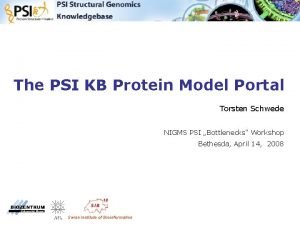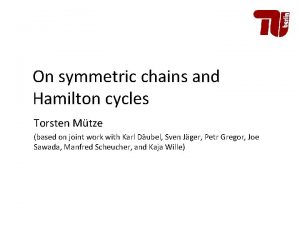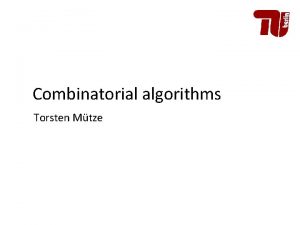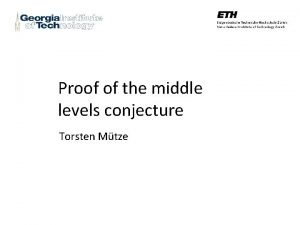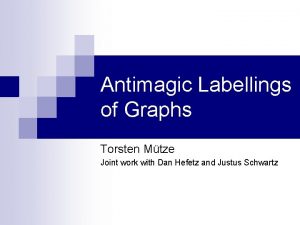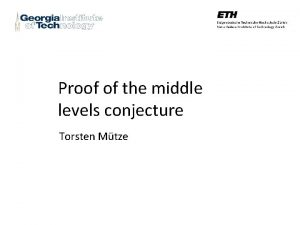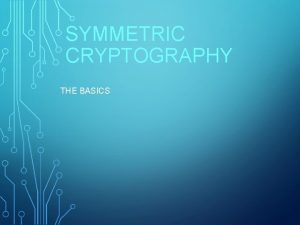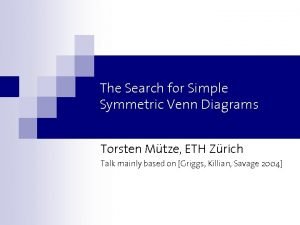On symmetric chains and Hamilton cycles Torsten Mtze



![Chain decompositions Theorem [Sperner 28]: The width (=size of a maximum antichain) of the Chain decompositions Theorem [Sperner 28]: The width (=size of a maximum antichain) of the](https://slidetodoc.com/presentation_image_h/bd6867a7fff9f35879d38c5d2faa5e41/image-4.jpg)









![Open problems • Conjecture [Shearer, Kleitman 79]: The -cube has pairwise orthogonal SCDs. known: Open problems • Conjecture [Shearer, Kleitman 79]: The -cube has pairwise orthogonal SCDs. known:](https://slidetodoc.com/presentation_image_h/bd6867a7fff9f35879d38c5d2faa5e41/image-14.jpg)

- Slides: 15

On symmetric chains and Hamilton cycles Torsten Mütze (based on joint work with Karl Däubel, Sven Jäger, Petr Gregor, Joe Sawada, Manfred Scheucher, and Kaja Wille)

The Boolean lattice • consider all subsets of ordered by inclusion • a fundamental and widely studied poset • called -cube • -th level : = all subsets of cardinality • its size is 4 -cube

The Boolean lattice • consider all subsets of ordered by inclusion • a fundamental and widely studied poset • called -cube • -th level : = all subsets of cardinality • its size is middle level(s) even odd
![Chain decompositions Theorem Sperner 28 The width size of a maximum antichain of the Chain decompositions Theorem [Sperner 28]: The width (=size of a maximum antichain) of the](https://slidetodoc.com/presentation_image_h/bd6867a7fff9f35879d38c5d2faa5e41/image-4.jpg)
Chain decompositions Theorem [Sperner 28]: The width (=size of a maximum antichain) of the -cube is given by the size of its middle level(s). Theorem [Dilworth 50]: Any poset can be decomposed into many chains. chain decomposition 4 -cube

Symmetric chain decompositions • useful for applications: symmetric chains, i. e. , if a chain starts at level , then it ends at level. • known constructions of SCDs for the -cube due to [De Bruijn, van Ebbenhorst Tengbergen, Kruiswijk 51], [Lewin 72], [Aigner 73], [White and Williamson 77], [Greene, Kleitman 76] • all constructions yield the same SCD not symmetric chain decomposition (SCD) 4 -cube

Parenthesis matching • useful for applications: symmetric chains, i. e. , if a chain starts at level , then it ends at level. • known constructions of SCDs for the -cube due to [De Bruijn, van Ebbenhorst Tengbergen, Kruiswijk 51], [Lewin 72], [Aigner 73], [White and Williamson 77], [Greene, Kleitman 76] • all constructions yield the same SCD • ‚parenthesis matching‘ description by [Greene, Kleitman 76] 1001110110 1001110100 100100 0001100100

Edge-disjoint and orthogonal SCDs • Question: Are there other constructions? • Definition: Two SCDs are edge-disjoint, if they do not share any edges • Definition: Two SCDs are orthogonal, if any two chains intersect in at most one element, except the two longest chains that may only intersect in and 4 -cube • Observe: orthogonal �edge-disjoint

Edge-disjoint and orthogonal SCDs • Question: How many pairwise edge-disjoint/orthogonal SCDs can we hope for? even • is an upper bound: every SCD uses exactly one of those edges • Conjecture [Shearer, Kleitman 79]: The -cube has pairwise orthogonal SCDs. • Theorem [Shearer, Kleitman 79]: The standard construction and its complements are two orthogonal SCDs. • Theorem [Spink 17]: The -cube has three pairwise orthogonal SCDs for.

Our results Theorem 1: The -cube has four pw. orthogonal SCDs for . Theorem 2: The -cube has five pw. edge-disjoint SCDs for . Proof of Theorem 2: • Product lemma: If the -cube and -cube have edge-disjoint SCDs each, then the -cube has edge-disjoint SCDs. • find five edge-disjoint SCDs for dimensions • Fact: If and are coprime, then every negative integer multiple of and is a non- computer search in the necklace poset Proof of Theorem 1: • similar, but more complicated product lemma due to [Spink 17] • find four orthogonal SCDs for dimensions and

The central levels problem Middle levels conjecture: The subgraph of the -cube induced by the middle two levels and has a Hamilton cycle. • problem with a long history • answered positively in [M. 16] Central levels conjecture: The subgraph of the -cube induced by the middle levels has a Hamilton cycle for any. • raised by [Savage 93], [Gregor, Škrekovski 10], [Shen, Williams 15] -cube

The central levels problem -cube • known results: Central levels conjecture: The subgraph of the[Gray 53] -cube induced by Hassan 01], [Locke, the middle levels[El-Hashash, has a Hamilton cycle for. Stong any 03] [Gregor, Škrekovski 10]. ? ? ? [M. 16]

Our results Theorem 3: The -cube has a Hamilton cycle through the middle four levels ( ) for all. Theorem 4: The -cube has a cycle factor through the middle for all and. spanning collection of disjoint cycles levels

The central levels problem Theorem Proof: 4: The -cube has a cycle factor through the middle. SCDslevels • consider two edge-disjoint for all and • as the. dimension is odd, all chains have odd length, even after restricting to middle levels • taking every second edge yields two edge-disjoint perfect matchings • their union is a cycle factor
![Open problems Conjecture Shearer Kleitman 79 The cube has pairwise orthogonal SCDs known Open problems • Conjecture [Shearer, Kleitman 79]: The -cube has pairwise orthogonal SCDs. known:](https://slidetodoc.com/presentation_image_h/bd6867a7fff9f35879d38c5d2faa5e41/image-14.jpg)
Open problems • Conjecture [Shearer, Kleitman 79]: The -cube has pairwise orthogonal SCDs. known: four • we conjecture that the disjoint SCDs. -cube has pairwise edgeknown: five • central levels problem: Can the cycles in the factor be joined to a single Hamilton cycle? first open case: Structure of the cycle factor? middle six levels • efficient algorithms to generate those cycles • exploit new SCD constructions in other applications (Venn diagrams etc. )

Thank you!











